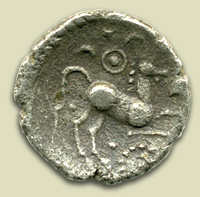BRITISH TRIBES
Since the Britons themselves (who, along with much of western Europe, spoke Celtic languages) left no literary record, their tribal names have come from Roman sources. Occasionally, a tribe can have the same, or very similar, name as another. This in itself cannot be taken as an indication that the tribes are related. With names that can be translated along the lines of: ‘hill people’, ‘people of the horn’, ‘hunters’, etc., similarities are to be expected. For administrative purposes, those parts of Roman Britain which were not under direct military control were divided into civitates (singular: civitas) – the equivalent of counties. A civitas was usually based on an existing tribal division, and retained the name of the tribe concerned.
In his Geography, of about AD 150, Greco-Egyptian mathematician, astronomer and geographer, Claudius Ptolemaeus, known as Ptolemy, produced a set of coordinates which allow a rudimentary map of the world as he knew it to be drawn. Britain’s shape (seen on the right) is actually very distorted on this map – the North skewing wildly eastwards. Ptolemy gives a description of the layout of tribal territories within Britain, and names and coordinates for a number of ‘towns’ – poleis (singular: polis) is the term he uses for all the named places, regardless of size or sophistication – which he allocates to the appropriate tribe. The following extract demonstrates the format:
| Below the Atrebatii [22 on the clickable mapmap at top of page] and the Cantii [21] are the Regni [24] and the town: | ||
| Noeomagus | 19°45′ | 53°25′ |
| Below the Dobunni [15] are the Belgae [23] and the towns: | ||
| Ischalis | 16° | 53°40′ |
| Aquae Calidae | 17°20′ | 53°40′ |
| Venta | 18°40′ | 53°30′ |
| Toward the west and south of these are the Durotriges [16] whose town is: | ||
| Dunium | 18° | 52°40′ |
| Next to these, but more to the west, are the Dumnonii [17] … Geography II, 3 |
||
Though Ptolemy was writing in the mid-2nd century, the bulk of his data was considerably older. He drew extensively on the work of one Marinus of Tyre, who was probably working in the years about AD 100, though, in the case of Britain, the original source of the material can only have been the Roman military.[*] As far as the poleis are concerned there are important omissions. Ptolemy had information regarding the placement of legions, dating from no earlier than AD 122, which he added to this incomplete picture.[*]
In about AD 98, Roman historian Tacitus wrote the following:
… whether the original inhabitants of Britain were indigenous or invaders has never been determined. Such ignorance is usual among barbarians. Their physical characteristics vary, and from this deductions may be drawn. The inhabitants of Caledonia [1] have red hair and large limbs: this betrays German origin. The Silures [12] have swarthy faces, and, for the most part, curly hair. Thus it seems probable that Iberians at one time crossed from the opposite coast of Spain and occupied this district. —
tri01
Britain is the largest of all the islands recognized in Roman geography. As to its size and position, it faces Germany on the east, Spain on the west, and on the south is within sight of Gaul. Its northern shores, which have no land opposite, are washed by a vast and open sea.Later, he mentions that:Agricola 10
… Ireland lay half-way between Britain and Spain …The notion that Britain’s west coast faced towards Spain is a recurring misconception. It was the opinion of Julius Caesar, and appears to be achieved by imagining that the coast of Gaul ran in a virtually straight line from the Rhine to the Pyrenees – in effect, rotating the British Isles, in an anti-clockwise direction, towards Spain.[*]Agricola 24
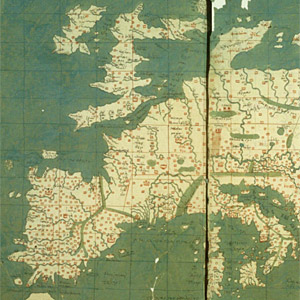
… the Ocean has islands which are called Britain and Ireland and which are located opposite the Gauls in the general direction of Spain … Britain, an island in the Ocean, extends for a long distance northward; to the south, it has the Gauls… Ireland, an island located between Britain and Spain, extends at greater length from south to north.History Against the Pagans I, 2
— Those who live nearest the Gauls resemble them. It may be that the influence of a common origin still persists, or, perhaps, as the two countries project side by side in opposite directions, their geographical position has determined their physique. Taking a general view, one may well believe that the Gauls occupied the neighbouring island. You may find in Britain their religious rites and beliefs: the language is much the same: they show the same daring in seeking danger, and when the crisis comes, the same timidity in drawing back. However, the Britons display more spirit: they have not yet been enervated by a long period of peace. We are told indeed that the Gauls too were once a great fighting people. Indolence came hand in hand with peace: courage and liberty perished together. The same fate has befallen those Britons who were conquered in Claudius’ invasion [of AD 43]: the others remain what the Gauls once were.
Their strength lies in their infantry, though some tribes also fight from chariots, in which the nobles ride themselves, while their dependants fight in front of them. In former days they owed obedience to kings; now they are torn by party factions between rival leaders. Our [i.e. the Romans] greatest advantage in coping with tribes so powerful is that they do not act in concert. It is rare for two or three tribes to unite against a common danger. They fight alone and fall together. Their climate is vile; constant rain and clouds. But extreme cold is unknown. The day lasts longer there than it does in our latitude. In the far north of Britain the night is light and short, and only a brief interval divides the end and the beginning of daylight. If clouds do not obscure the sun, its rays can be seen by night. It does not set or rise, so they declare, but merely passes across the horizon. The fact is that the land at this extremity of the earth is flat, and casts a low shadow: thus the darkness does not reach very high, and night falls below the level of the sky and stars.
Although the olive and the vine and the other peculiar products of warmer countries do not grow there, the soil is fertile and bears crops. They sprout up quickly, but are slow to ripen. The cause is in both cases the same – the abundant moisture of the ground and climate. Britain contains gold and silver and other metals, which reward our conquest. The sea also produces pearls, but they are of a dull leaden hue. Some attribute this to the divers’ lack of skill: for in the Red Sea the oysters are torn alive and breathing from the rocks, while in Britain they are gathered as the sea casts them up. Personally I could sooner believe the pearls deficient in quality than mankind in greed.
The Britons themselves readily support levies and taxes and such burdens as the government enjoins, so long as their pride is not hurt. Insult they cannot bear. They have been tamed to obedience, but not yet to servitude.Agricola 11–13
1:Caledonia
10:Taexali
11:Epidii
12:Venicones
6:Carnonacae
7:Creones
8:Caledonii
2:Caereni
3:Smertae
4:Lugi
Northern Scotland (as it is called today), i.e. beyond the line of the Forth and Clyde estuaries, was never fully brought under Roman occupation. Ptolemy lists twelve tribes living in this country. (His list, though, may well be incomplete.) From his description, it is possible to, very approximately, map their territories (see right). The Caledonii appear as a particular tribe, living in the vicinity of the Great Glen. From Tacitus, however, it is evident that the term Caledonia was used, in a generalized way, to refer to the whole land-mass – “an immense, shapeless tract of country narrowing into a sort of wedge” (Agricola 10) – north of the Forth-Clyde line. Because of the narrowness of the neck of land between the Firths of Forth and Clyde, Tacitus remarks that the country to its north seemed like “another island” (Agricola 23). He also notes:
The inhabitants of Caledonia have red hair and large limbs: this betrays German origin.Agricola 11
Tacitus reports that Gnaeus Julius Agricola (governor of Britain AD 77–84[*]) routed the combined forces of the Caledonian tribes, at the battle of Mons Graupius in 83, then:
… led his army down into the territory of the Boresti.Agricola 38
Although there is speculation, the whereabouts of Mons Graupius and the “territory of the Boresti” remain unknown. The Boresti are the only Caledonian tribe named by Tacitus. Their mention in Agricola is the only record of their existence, and it has been suggested that they are actually the product of a textual corruption[*]. Agricola also had his fleet circumnavigate Caledonia, which confirmed to Roman satisfaction that Britain was indeed an island. No doubt data collected during the voyage would eventually furnish Ptolemy with his source material for the North.
A number of forts (often called ‘glen-blocking forts’) had been built along the edge of the Highland massif (a line which runs from the Clyde to Stonehaven), and, at Inchtuthil in Perthshire, construction of the most northerly legionary fortress of the Empire was underway, when, in 87, there was an abrupt change of plan. One of Britain’s four legions was withdrawn for service on the Danube. The, still unfinished, fortress was dismantled and the Romans vacated Caledonia. They apparently maintained a presence in, what is now, southern Scotland for a few more years, but by about 105 they had retreated to the Tyne-Solway line. Emperor Hadrian visited Britain in 122, and ordered the construction of a frontier wall, Hadrian’s Wall, along this line. In 142 the Romans reoccupied southern Scotland, and another wall, the Antonine Wall, was built across the Forth-Clyde isthmus. The Antonine Wall defined the Empire’s frontier for twenty-odd years, before the Romans were obliged to withdraw to Hadrian’s Wall.[*]
A final attempt to bring the whole of Britain into the Empire was made in 208, when Septimius Severus personally led an army into Caledonia. In 211 Severus died, at York, without having achieved a decisive result. His son and successor, Caracalla, had no enthusiasm for the campaign, and abandoned his father’s gains. Hadrian’s Wall was again, and finally, the frontier of the Empire.[*]
2:Damnonii 3:Novantae 4:Selgovae 5:Votadini
The Damnonii, Novantae, Selgovae and Votadini are tribes placed by Ptolemy in the territory between two ‘lines’: the Forth-Clyde and the Tyne-Solway, which, at different times, acted as the Empire’s frontier. The Votadini [5] would seem to have occupied the eastern side of this region. In the Clyde valley and Ayrshire, were the Damnonii [2].[*] (Their name could also be spelled Dumnonii, but there is no reason to suspect a connection between this tribe and the Dumnonii [17] of the far south-west of England.) South of the Damnonii, in Dumfries and Galloway, were the Novantae [3]. The Selgovae [4] – their name is believed to mean ‘hunters’ – occupied the centre of the region. (The territory occupied by these tribes comprises, in modern terms, southern Scotland, and, to the south-east, a wedge of northern England. For convenience, the whole region will be referred to as southern Scotland.)
In AD 78, Gnaeus Julius Agricola (governor of Britain 77–84) began his campaigns in the north of the island. By the end the campaigning season of 79, the tribes of southern Scotland had been conquered. Agricola recognized the Forth-Clyde line’s potential as a frontier, and he spent the next year consolidating his gains up to that line. Beyond the Forth-Clyde was Caledonia [1]. Agricola won a major victory over the combined Caledonian tribes (at Mons Graupius), in 83, before being recalled to Rome.[*] The Empire’s priorities, however, lay elsewhere. A legion was withdrawn from Britain, and, in 87, the Romans abandoned Caledonia. They continued to occupy forts in southern Scotland, but it seems that by c.105 these too were abandoned (perhaps as the result of hostilities), and the Romans withdrew to the Tyne-Solway line. The Tyne-Solway frontier was formalized by the construction of Hadrian’s Wall – ordered by the emperor Hadrian, on a visit to Britain, in 122. In 142, however, on the instructions of Antoninus Pius (who had succeeded Hadrian in 138), the Romans retook southern Scotland. A new frontier wall, the Antonine Wall, was built across the Forth-Clyde isthmus. Southern Scotland was occupied for twenty-odd years, before the Romans were, again, obliged to pull back to the Tyne-Solway line.[*]
In 208, Septimius Severus began a campaign in Caledonia, but, after his death (in 211, at York), Hadrian’s Wall once more, and finally, became the frontier of the Empire.[*] Although they were beyond the frontier of Rome, the tribes of southern Scotland (they are often referred to as ‘the tribes between the walls’) were not beyond the influence of Rome. Several outposts to the north of Hadrian’s Wall were garrisoned – the area being, in effect, a buffer zone between the ‘barbarian’ North and civilized Roman Britain.
6:Carvetii 7:Brigantes 8:Parisi
The Brigantes [7] occupied most of northern England. “Extending to both seas”, notes Ptolemy (Geography II, 3). “The most populous, so they say, in the whole province”, remarks Tacitus (Agricola 17). The name Brigantes means ‘high ones’, probably, since their territory straddled the Pennines, in the literal sense of ‘hill people’, rather than in any figurative sense implying superiority.[*] The Tyne would seem to have been their north-eastern limit, whilst to the west their territory may well have extended into southern Scotland – in which case some of the Brigantes would have been cut-off from their fellows when the emperor Hadrian ordered his Wall to be built across Britain, along the Tyne-Solway line, in 122.[*] Their southern boundary appears to have dipped down from the line of the Humber and Mersey to include the Peak District.[*]
There are clues to suggest that the Brigantes were a federation of smaller tribal groups (often called ‘septs’).[*] Ptolemy, for instance, places a ‘port of the Setantii’ on the Lancashire coast, in the vicinity of Fleetwood, and a ‘bay of the Gabrantovices’ on the North Yorkshire coast. There is epigraphic evidence for groups called the Textoverdi and the Corionototae round-about the middle of the Tyne-Solway line.
tri02
… Quintus Calpurnius Concessinius, prefect of cavalry, after slaughtering a band of Corionototae, fulfilled his vow to the god of most efficacious power.Presumably the Corionototae were from the north of Hadrian’s Wall. It is widely suggested that they were a sept of the Brigantes.[*] Since 1973, hundreds of writing tablets (slivers of wood, written on with pen and ink), dating from c.85 to c.120, have been excavated at Vindolanda. It has become apparent from these that Roman Corbridge was called Coria. The name is not unique. Ptolemy lists two poleis of that name, neither of which is assigned to the Brigantes – one is assigned to the Damnonii [2], the other to the Votadini [5].[*] In the native Brythonic language, coria probably had the meaning ‘hosting-place’ – indicating a tribal centre. In the Antonine Itinerary (Iter I of the British section) Roman Corbridge is called Corstopitum, but this must be a corruption.[*] In the, famously garbled, Ravenna Cosmography appears, apparently in the right sort of geographical vicinity, Corie Lopocarium. Evidently disregarding the Antonine Itinerary, the notion that Corbridge was the coria of a Brigantian sept called the Lopocares seems to have taken root.RIB 1142
In about AD 49, Publius Ostorius Scapula, governor of Britain (47–52), was obliged to abandon a campaign in, what is now, Wales to deal with a rebellion amongst the Brigantes. Tacitus reports:
The Brigantian rising, it is true, subsided on the execution of a handful of men, who were beginning hostilities, and the pardon of the rest …Annals XII, 32
The Brigantes were ruled by Queen Cartimandua. The massive earthwork complex at Stanwick, North Yorkshire, may have been her capital.[*] Cartimandua was an ally of the Romans, a client-ruler. In 51, when the British resistance leader Caratacus sought her protection, she cemented her relationship with Rome by handing him over in chains.
Since the capture of Caratacus, however, the Briton with the best knowledge of the art of war was Venutius from the state of the Brigantes, as mentioned earlier[*]. He had long been loyal, and had received the protection of the Roman arms during his married life with Queen Cartimandua: then had come a divorce, followed by immediate war, and he had extended his hostility to ourselves [i.e. the Romans].Tacitus Annals XII, 40
The feud between Cartimandua and Venutius rumbled on for several years – she managing to retain her position thanks to Roman intervention. She alienated her subjects by taking her erstwhile husband’s armour-bearer as her new husband and co-ruler. In 69 (the Year of the Four Emperors), when the Romans were preoccupied with civil war, Venutius launched an attack, and, although Roman forces managed to rescue Cartimandua, he captured the kingdom. In 71, the first task undertaken by, new governor, Quintus Petillius Cerialis (71–73/74) was to sort out the Brigantes:
Engagements were frequent, and the losses often heavy; and his conquests, or at least his wars, embraced a great portion of the Brigantes.Tacitus Agricola 17
The legionary fortress of Eboracum (York) is presumed to have been founded at this time, and dendrochronology has demonstrated that timbers from the first Roman fort at Luguvalium (Carlisle) were felled in the winter of 72/73. What happened to Cartimandua and Venutius is not recorded, but Tacitus seems to imply (Agricola 20) that it was not until the second campaigning season of his father-in-law, Gnaeus Julius Agricola (governor of Britain 77–84), i.e. in 78, that Rome’s grip on all the Brigantes’ territory was fully secured.[*]
Later – in the aftermath of Hadrian’s British visit of 122 seems likely – a civitas was established amongst the Brigantes. Its capital, Isurium Brigantum, is now Aldborough, North Yorkshire. Greek traveller and geographer, Pausanias, writing in the late-170s, makes a passing comment that Hadrian’s successor, Antoninus Pius (ruled 138–161):
… annexed the greater part of the territory of the Brigantes in Britain, because the Brigantes started an invasion of Genounia, which is subject to Rome.Description of Greece VIII, 43
Pausanias’ remark, as his text has survived anyway, does not make sense. The whereabouts of his “Genounia” is unknown, and it must be suspected that there has been confusion between the British Brigantes and the Brigantii, around Bregenz in Austria, who had neighbours called the Genauni. However, coins issued in 155, depicting a dismayed looking Britannia, are interpreted as commemorating a recent Roman victory in Britain, and it is commonly suggested that Pausanias’ remark and the coins pertain to the suppression of a rebellion of the British Brigantes.[*]
The Carvetii [6], whose name probably means ‘deer men’, lived in what is now Cumbria. They were not listed by Ptolemy, and, at the time he produced his Geography (mid-2nd century AD), they may well have been a sept of the Brigantes. However, they are known to have been a distinct civitas from three inscriptions – one on a, now lost, tombstone (RIB 933) and two on milestones (RIB 3525, 3526). The earlier of the milestones (found at Langwathby, near Penrith, in 1993) carries a dedication to the emperor Alexander Severus (reigned 222–235) dated 223 (RIB 3526), so, clearly, the civitas had to have been established by then. Luguvalium (Carlisle) is presumed to have been its capital.
Living in what is now East Yorkshire were the Parisi [8]. Ptolemy assigns them only one town, Petuaria, which is presumed to have been the civitas capital. Petuaria was probably located at the village of Brough, on the River Humber. In 1937, excavations at Brough uncovered an inscribed stone (RIB 707). It records the donation of a new theatre stage (proscaenium) by an aedile – a class of magistrate appropriate for a civitas capital – of Petuaria. The inscription dates from between 140 and 144, during the reign of Antoninus Pius (138–161), in whose honour the donation had been made. It would seem reasonable to assume that the civitas Parisorum was constituted about the same time as the civitas Brigantum – during Hadrian’s reign (117–138), some time after his visit to Britain of 122. There are, however, nagging doubts over the identification of the site at Brough with Petuaria. The inscribed stone had been incorporated into the fabric of a later (early-4th century) building. Presumably the erstwhile theatre, and hence Petuaria, was in the vicinity, but excavations suggest that Brough was a military base, rather than a civitas capital.[*]
There was a tribe called the Parisii in Gaul (after whom the French capital is named). Whilst a shared name does not necessarily indicate a link between the two tribes, in this case there is a more tangible reason for suspecting a connection. The area of Britain where the Parisi lived is also the area where the distinctive, Iron Age, ‘Arras culture’ burial practices are found – practices which have parallels on the Continent, but are virtually unique in Britain (see A Way of Death).
9:Deceangli 10:Ordovices 11:Demetae 12:Silures
The Deceangli, Ordovices, Silures and Demetae occupied the area of Britain which is now Wales. Ptolemy records the Demetae [11] in the south-west (though the name given to St David’s Head, Octapitarum Promontorium, suggests that area was inhabited by a group called the Octapitae) and the Silures [12] in the south-east, but the rest of Wales he assigns to the Ordovices [10] (though the Llŷn Peninsula, the Ganganorum Promontorium, would appear to have been populated by a group called the Gangani[*]). Not mentioned by Ptolemy are the Deceangli [9] of north-eastern Wales. In about AD 49, Publius Ostorius Scapula, governor of Britain (47–52), marched against the Deceangli. Actually, Tacitus, who reports the event in his Annals, calls the tribe the Decangi, but inscriptions on lead ingots suggest it should really be Deceangli.
tri03
 I.A. Richmond, in Roman Britain (1955) Chapter 4 (p.152), writes:
I.A. Richmond, in Roman Britain (1955) Chapter 4 (p.152), writes:
The pigs from the Flintshire area are stamped Deceangl, for metallum Deceanglicum, the name surviving in the medieval district of Tegeingl [between the rivers Dee and Clwyd] …Anthony R. Birley, in The Roman Government of Britain (2005) p.29 n.51, prefers to expand DECEANGL to plumbum Deceanglicum, but no matter. Scholarly opinion is, it seems, virtually unanimous that Tacitus’ Decangi and the Deceangli, in whose territory lead was produced, are one and the same. Michael G. Jarrett and J.C. Mann write*:
The name of this tribe is recorded as Deceangli on lead pigs. Tacitus speaks of the Decangi, and it is generally assumed (and will be here) that this is the same group. It is, however, possible that Decangi is really a scribal error for another group, the Decanti. The Decanti are known only from a post-Roman reference, and Degannwy, Caerns. (SH 782795), is the only place known to belong to them.[*] It is presumed that they are a separate tribe, for it is difficult to envisage the scribal error or philological change which would produce Decanti from Deceangli.* ‘The Tribes of Wales’ The Welsh History Review Vol. 4, No. 1 (June 1968), freely available online.
Either way:
The country was devastated, booty collected everywhere, while the enemy declined to risk a battle, or, if he made a stealthy attempt to harass the marching columns, found his treachery punished. And now Ostorius was within measurable distance of the sea which looks towards Ireland, when an outbreak of sedition among the Brigantes [7] recalled a leader who was firm in his resolution to attempt new conquests only when he had secured the old.Annals XII, 32
When the Brigantes had been sorted out – a simple operation apparently – Ostorius Scapula again turned his attention to Wales. Tacitus makes no further mention of the Decangi, but reports:
… neither severity nor clemency converted the tribe of the Silures [12], which continued the struggle and had to be repressed by the establishment of a legionary camp.[*]Annals XII, 32
Tacitus talks of the Silures’ “native boldness” (Annals XII, 33), and in Agricola (§11), he notes that:
The Silures have swarthy faces, and, for the most part, curly hair. Thus it seems probable that Iberians at one time crossed from the opposite coast of Spain and occupied this district.[*]
Anyway, by this time (c.50), the forces of the Silures were under the direction of, the famous British resistance leader, Caratacus:
… whose many successes, partial or complete, had raised him to a pinnacle above the other British leaders. But on this occasion, favoured by the treacherous character of the country, though inferior in military strength, he astutely shifted the seat of war to the territory of the Ordovices [10] where, after being joined by all who feared a Roman peace, he put the final chance to trial.Annals XII, 33
Though Caratacus was defeated and taken captive to Rome, in 51, the struggle continued.
Particularly marked was the obstinacy of the Silures, who were infuriated by a widely repeated remark of the Roman commander [i.e. Ostorius Scapula], that, as once the Sugambri [a Germanic tribe] had been exterminated or transferred to the Gallic provinces, so the Silurian name ought once for all to be extinguished. They [the Silures] accordingly cut off two auxiliary cohorts which, through the cupidity of their prefects, were ravaging the country too incautiously; and by presents of spoils and captives they were drawing into revolt the remaining tribes also …Annals XII, 39
At this point (52), Ostorius Scapula died – “broken by the weary load of anxiety”. Aulus Didius Gallus was appointed governor:
In spite of a rapid crossing, he found matters deteriorated, as the legion under Manlius Valens had been defeated in the interval. Reports of the affair were exaggerated: among the enemy, with the hope of alarming the commander on his arrival; by the commander – who magnified the version he heard – with the hope of securing additional credit, if he settled the disturbances, and a more legitimate excuse, if the disturbances persisted. In this case, again, the loss had been inflicted by the Silures, and they carried their forays far and wide, until repelled by the advent of Didius.Annals XII, 40
In 57, Didius Gallus was replaced by Quintus Veranius. He died within a year of his appointment, “after harrying the Silures in a few raids of no great significance” (Annals XIV, 29).
The next governor was Gaius Suetonius Paullinus (58–61). During the first two years of his appointment he is said to have subdued, unnamed, tribes and strengthened garrisons (Agricola 14). It seems reasonable to suppose that if the Deceangli hadn’t already submitted they did so at this time.[*] Encouraged by his success, in 60 Paullinus attacked the island of Mona (Anglesey), “which had a considerable population of its own, while serving as a haven for fugitives” (Annals XIV, 29). Before he had completed the island’s conquest, however, he was compelled to abandon his activities in Wales to deal with Boudica’s Rebellion. The Romans did not resume their subjugation of the Welsh tribes until the mid-70s.
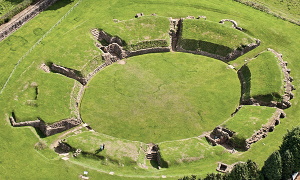
The “strong and warlike nation of the Silures” was finally subdued by the governor Sextus Julius Frontinus (73/74–77): “triumphing over the bravery of the enemy and the difficulties of the country” (Agricola 17). The legionary fortress of Isca (Caerleon, near Newport) was founded at this time.[*] Frontinus had apparently also overrun the Ordovices. At the end of his tenure as governor, shortly before his successor, Gnaeus Julius Agricola (77–84), arrived in Britain, “the Ordovices had surprised and almost annihilated a cavalry regiment [ala] stationed in their district” (Agricola 18). Agricola was keen to demonstrate that he was not a fellow to be trifled with, and, though it was late in the campaigning season (of 77), he swung into action against the Ordovices. According to Tacitus:
Almost the whole of the tribe was put to the sword.Agricola 18
Agricola quickly followed-up on this success by completing the conquest of Mona.[*]
The Deceangli [9] and the Ordovices [10] probably remained under military rule. In the south, however, it is a different story. The Silures [12] certainly became a civitas – the village of Caerwent, about eight miles east of Caerleon, is the site of the civitas capital: Venta Silurum.[*] The Demetae [11], who are not mentioned at all by Tacitus, but who were evidently also subdued by Frontinus, probably became a civitas. Although there is no written evidence – literary or epigraphic – excavations at Moridunum (Carmarthen) have strongly indicated that it was civitas capital of the Demetae.[*] When these civitates were established is not certain, but during reorganisation following Emperor Hadrian’s visit to Britain of 122 seems likely.[*]
13:Cornovii 14:Corieltavi 15:Dobunni
These tribes lived in the midlands of, what is today, England. In the north-west of the region were the Cornovii [13]. Ptolemy attributes two towns to them: Deva (modern Chester) and Viroconium. The site of Viroconium – more fully: Viroconium Cornoviorum, civitas capital of the Cornovii – is the village of Wroxeter, Shropshire. The civitas would have been established after Viroconium was finally abandoned as a legionary base, apparently in favour of Deva, about AD 90. It was certainly in full swing by 130 – demonstrated by the (confidently reconstructed[*]) date on an inscription (RIB 288) recording the building of the forum at Viroconium, dedicated to Emperor Hadrian (reigned 117–138) by the civitas Cornoviorum. Viroconium became the fourth largest town in Roman Britain.[*]
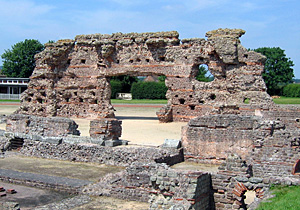
The Cornovii share their name with a Caledonian tribe [1], placed by Ptolemy in the far north-east of Scotland. As far removed from there as it is possible to get in Britain, in the south-western extremity of England, the Ravenna Cosmography locates a place called Purocoronavis. The text of the Cosmography is, however, famously corrupt. Accordingly, Purocoronavis has been unscrambled to produce Durocornovium – the Duro prefix meaning ‘fortress’ in the native Celtic language, so: ‘fortress of the Cornovii’.[*] Presumably, these Cornovii were a division of the Dumnonii [17]. The Antonine Itinerary also places (Iter XIII of the British section) a Durocornovium between Glevum (Gloucester) and Calleva Atrebatum (Silchester). This Durocornovium is usually identified with the remains of a small Roman town adjacent to the village of Wanborough, Wiltshire. Cornovii evidently has the meaning ‘people of the horn’ (Celtic element corn being ‘horn’). In the case of the south-western tribal group, the ‘horn’ could be the peninsula on which they lived – the term survives in the county name Cornwall (the ‘wall’ element coming from Walas or Wealas, the Anglo-Saxon name for native Britons). In other cases, ‘horn’ may be literally that – perhaps in reference to a horned god. In short, there is no reason to assume that the various groups who shared the name Cornovii were related.
The Corieltavi [14] occupied the eastern midlands of England. They issued coins before the arrival of the Roman invaders. From early in the 1st century AD their coins were inscribed with, presumably(?), the names of their leaders. Some of the inscriptions are abbreviated to such an extent that the actual names are obscure, but it seems that coins were commonly issued with two (e.g. AVN COST), or in one case three (DVMNO TIGIR SENO), names on them – though some of these ‘names’ could possibly be mint-marks, epithets or titles. Coins inscribed VEP CORF could refer to two individuals, or just one: VEP, son of COR (F=Filius). Inscriptions on the late coinage are less fiercely contracted, and VOLISIOS is, in different issues, associated with three other names: DVMNOCOVEROS, DVMNOVELLAVNOS and CARTIVEL.[*] Was VOLISIOS the supreme leader and the other three his subordinates? Maybe. At any rate, it is generally believed that the Corieltavi had some form of shared leadership.
In fact, Ptolemy called this tribe the Coritani or Coritavi (depending on the manuscript). Recent detective work, however, has indicated that their name was really the Corieltavi.
tri04
The Case of the Tripontium Tile
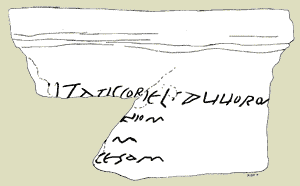 Tomlin interpreted the characters VV as the letters ‘uv’, so the inscription referred to the civitas Corieltauvorum, i.e. ‘the civitas of the Corieltauvi’.
Until this time it had generally been assumed that the author of the Ravenna Cosmography had garbled the name of the civitas capital of Ptolemy’s Coritani/Coritavi as Ratecorion (indeed, this supported Coritani as being the preferable manuscript reading – Ratecorion being taken to be Ratae Coritanorum).[*] The next place listed by the Cosmographer being, the unidentified, Eltauori. In view of his new reading of the inscription, though, Tomlin concluded that, rather than being two places, Ratecorion and Eltauori are scrambled parts of the same civitas capital name: Ratae Corieltauvorum. Therefore, Ptolemy’s Coritani/Coritavi were really called the Corieltauvi.
Well, as previously mentioned, in 1983 R.S.O. Tomlin had interpreted the inscription’s VV as ‘uv’, but, following a paper by Andrew Breeze, published in 2002, he revised his opinion and issued a correction: “The name of the civitas in this graffito should be ‘Corieltavi’ (with v pronounced like English w), not ‘Corieltauvi’ (with the diphthong au).”[*] The tribal name, then, is properly Corieltavi, but the name Corieltauvi still seems to be widely used.
Tomlin interpreted the characters VV as the letters ‘uv’, so the inscription referred to the civitas Corieltauvorum, i.e. ‘the civitas of the Corieltauvi’.
Until this time it had generally been assumed that the author of the Ravenna Cosmography had garbled the name of the civitas capital of Ptolemy’s Coritani/Coritavi as Ratecorion (indeed, this supported Coritani as being the preferable manuscript reading – Ratecorion being taken to be Ratae Coritanorum).[*] The next place listed by the Cosmographer being, the unidentified, Eltauori. In view of his new reading of the inscription, though, Tomlin concluded that, rather than being two places, Ratecorion and Eltauori are scrambled parts of the same civitas capital name: Ratae Corieltauvorum. Therefore, Ptolemy’s Coritani/Coritavi were really called the Corieltauvi.
Well, as previously mentioned, in 1983 R.S.O. Tomlin had interpreted the inscription’s VV as ‘uv’, but, following a paper by Andrew Breeze, published in 2002, he revised his opinion and issued a correction: “The name of the civitas in this graffito should be ‘Corieltavi’ (with v pronounced like English w), not ‘Corieltauvi’ (with the diphthong au).”[*] The tribal name, then, is properly Corieltavi, but the name Corieltauvi still seems to be widely used.
Ptolemy assigned them the towns of Lindum (Lincoln) and Ratae (Leicester). The legionary fortress of Lindum was seemingly abandoned by c.80 – its resident legion (II Adiutrix) having moved to the new fortress of Deva (Chester). Later, probably c.90, Lindum was converted into a colonia (a town for legionary veterans).
tri05
 II Adiutrix probably arrived in Britain in 71, and they left about 87.[*] Inscriptions place them at Lindum and Deva. It is assumed it was they who built the fortress of Deva. By 78 the subjugation of Wales had been completed, and the attention of Gnaeus Julius Agricola, governor of Britain 77–84, was focussed on the North.[*] Perhaps it was the removal of units from Deva for Agricola’s advance into Scotland that caused work on the elliptical building to be abandoned.
An inscription (CIL XIII, 6679) from Mainz (Germany) dates the Lindum colonia to the Flavian dynasty, i.e. Vespasian (69–79) and his sons Titus (79–81) and Domitian (81–96). It seems that Lindum was a legionary fortress until the late 70s, and if the colonia had been founded by Agricola (probably left Britain in the spring of 84), his son-in-law and biographer, Tacitus, would have surely mentioned it.
II Adiutrix probably arrived in Britain in 71, and they left about 87.[*] Inscriptions place them at Lindum and Deva. It is assumed it was they who built the fortress of Deva. By 78 the subjugation of Wales had been completed, and the attention of Gnaeus Julius Agricola, governor of Britain 77–84, was focussed on the North.[*] Perhaps it was the removal of units from Deva for Agricola’s advance into Scotland that caused work on the elliptical building to be abandoned.
An inscription (CIL XIII, 6679) from Mainz (Germany) dates the Lindum colonia to the Flavian dynasty, i.e. Vespasian (69–79) and his sons Titus (79–81) and Domitian (81–96). It seems that Lindum was a legionary fortress until the late 70s, and if the colonia had been founded by Agricola (probably left Britain in the spring of 84), his son-in-law and biographer, Tacitus, would have surely mentioned it.
The name Ratae is derived from a Celtic language word that means ‘ramparts’, but, although there is evidence that there was an important pre-Roman settlement, no evidence has yet been found of any ramparts. There is also very little evidence for the presence of the Roman army.[*] However, probably c.100 (when a street-grid was laid out), Ratae became civitas capital of the Corieltavi.
The Dobunni [15] issued coins prior to the Roman Conquest. The distribution of coin finds places the tribe in the south-west of the English midlands (Gloucestershire and most of Worcestershire, extending into Oxfordshire, Wiltshire and Somerset). Beginning about three decades before the end of the 1st century BC, the abbreviated names of, what are assumed to be, their rulers appear on the coinage. There seems, however, to be no scholarly consensus regarding the chronological order in which the coins were issued – and hence the sequence of the named rulers. Further, recent finds have apparently eroded the idea that coin-distribution maps indicate the Dobunni were divided – two named kings simultaneously ruling different parts of the tribal territory.[*]
However, Cassius Dio also hints at a divided tribe. Dio (Roman History LX, 20) comments that Aulus Plautius, commander of the Roman invasion forces in AD 43, “gained by capitulation a part of the Bodunni [there is general agreement that the Bodunni are actually the Dobunni]”, and that these people were, at the time, subject to the Catuvellauni [19].[*]
Soon after the invasion (c.45), the Romans built a fort at a place they called Corinium, about 3 miles to the south of a native ‘territorial oppidum’ at Bagendon, Gloucestershire. This first fort was replaced, c.50, by a cavalry fort. It appears that the attraction of the ‘bright lights’ of the settlement (vicus) that subsequently developed at Corinium persuaded the locals to abandon their oppidum.[*] After the army moved on, probably in the mid-70s, Corinium became civitas capital of the Dobunni, i.e. Corinium Dobunnorum. The town, today Cirencester, became the second largest in Roman Britain (Londinium being the largest).
Ptolemy only attributes one town to the Dobunni, and that is Corinium. Some 16 miles north-west of Corinium, though, was Glevum (modern Gloucester), where, on the site of a vacated legionary fortress, a colonia was established during the reign of Nerva (96–98).[*]
It is possible that the southernmost territory of the Dobunni was incorporated into another civitas: the Belgae [23]. The Belgae (their capital, Venta Belgarum, is now Winchester, Hampshire) appear to have been an artificial civitas contrived by the Romans, and Ptolemy seems to assign Bath – which would be expected, by reason of coin-distribution, to have belonged to the Dobunni – to them.
16:Durotriges 17:Dumnonii
The Durotriges and the Dumnonii lived in the south-west of, what is now, England. The Durotriges [16] are thought to have been a confederation of smaller tribal groups. They minted coins before the Roman conquest, but they were never inscribed with the name of a ruler. The distribution of their coins indicate the Durotriges occupied the whole of Dorset, extending into adjacent counties, particularly Somerset, through which they had a connection to the Bristol Channel. When the Romans invaded, in AD 43, Vespasian (the future emperor) was in command of Legio II Augusta as it marched into the south-west.[*] In his biography of Vespasian, Suetonius reports that:
… he fought thirty battles with the enemy. He reduced to subjection two powerful nations, more than twenty towns [actual word: oppida], and the island of Vectis [Isle of Wight], near Britain …Lives of the Twelve Caesars ‘The Deified Vespasian’ 4
That one of the “two powerful nations” was the Durotriges seems certain; the identity of the other is less so. The twenty oppida taken by Vespasian would have to be hillforts, of which there are many in the Durotriges’ territory, and which, although their heyday had past, the Durotriges continued to use. (Evidence of combat has been unearthed at Dorset hillforts.[*]) The one town assigned to the Durotriges by Ptolemy is, the otherwise unknown, Dunium. Maiden Castle – largest ‘developed hillfort’ in Britain – is probably the current favourite candidate for Dunium, but the hillfort of Hod Hill and a cross-Channel trading centre at Hengistbury Head also have their advocates.
Just a couple of miles to the north-east of Maiden Castle sprang up the Roman town of Durnovaria (modern Dorchester, Dorset). It is presumed that, in typical fashion, Durnovaria started as a vicus, though its fort has proved elusive. There is no written evidence, literary or epigraphic, but the town’s development makes it pretty certain that Durnovaria became civitas capital of the Durotriges when the Roman military moved on (probably c.65). However, two inscriptions (RIB 1672 & 1673) from Hadrian’s Wall record working-parties of a civitas Durotrigum Lendiniensis: ‘the civitas of the Durotriges of Lendiniae’.[*] The Ravenna Cosmography gives the name of a place, evidently in the territory of the Durotriges, as Lindinis. It seems clear that the name Lendiniae of the inscriptions equates to the Cosmographer’s Lindinis, and it is now generally accepted that Ilchester, “the only Roman town of any size in the territory of the Durotriges apart from Durnovaria”[*], is that place. The inscriptions, then, may imply that, at some stage (though it could be earlier, the 4th century appears to be the most popular guess), the civitas of the Durotriges was divided – the northerly part having its capital at, what is today, Ilchester.[*]
The Dumnonii [17] inhabited the south-west peninsula of England (any connection with the Damnonii [2], who lived in southern Scotland, is very unlikely). Their border with the Durotriges was probably the Parrett-Axe line. The Dumnonii did not mint coins or have any large settlements – they were probably a grouping of small tribes. Their culture had more in common with their neighbours, and trading partners, across the Channel, on the Armorican peninsula (now Brittany) in Gaul, than with their neighbours in Britain.[*]
The Ravenna Cosmography locates a place called Purocoronavis in the south-west. The text of the Cosmography is, however, famously corrupt. Accordingly, Purocoronavis has been unscrambled to produce Durocornovium – the Duro prefix meaning ‘fortress’ in the native Celtic language, so: ‘fortress of the Cornovii’.[*] Cornovii evidently has the meaning ‘people of the horn’ (Celtic element corn being ‘horn’). Presumably these Cornovii – it is a name shared by other tribal groups in Britain, e.g. [13] – were a division of the Dumnonii. Perhaps in this instance corn is a reference to the peninsula on which they lived – the term survives in the county name Cornwall (the ‘wall’ element coming from Walas or Wealas, the Anglo-Saxon name for native Britons) – but it could be a reference to a horned animal, or perhaps a horned god.
It would seem reasonable to suppose that one of the “two powerful nations”, that Suetonius reports were subdued by Vespasian, who had command of Legio II Augusta, was the Dumnonii. It could be so, but Vespasian probably left Britain in 47, and the archaeological evidence tends to suggest that the Dumnonii weren’t subjugated until the 50s. The legionary fortress of Isca (now Exeter) seems to have been founded about 50–55. After its legion, i.e. II Augusta, moved on – in the mid-70s seems likely – Isca became civitas capital: Isca Dumnoniorum.
tri06
The idea that Isca may have been a fortress of the 2nd Augustan Legion, originating from a reference occurring in some editions of Ptolemy’s Geography must, I think, now be finally given up.In her autobiography, Aileen Fox picks-up the story:Roman Exeter (Isca Dumnoniorum): Excavations in the War-damaged Areas, 1945-1947 (1952), p.16.
I had to wait to prove myself wrong until 1964, when I found a ditch of definite military character and early date outside the south gate of the city. In 1971 the discovery, by the newly-founded Exeter Archaeological Field Unit, beneath the recently-demolished Church of St Mary Major in the Close [in front of the west entrance to Exeter Cathedral], of a great military bath house subsequently converted into the Basilica and civic centre, clinched the matter.In short, there is, indeed, a legionary fortress, dating from about 50–55 until about 75–80, underlying Exeter. Furthermore, it is virtually certain – no inscription has been found to put the matter completely beyond doubt – that II Augusta was stationed at Exeter. Although the fortress at Caerleon was built c.75, II Augusta are not definitively placed there, by an inscription (RIB 330), until 100. However, two terracotta antefixes (roof ornaments), featuring a pair of dolphins, from the Exeter bath-house were found to have been cast in the same mould as antefixes found at Caerleon.[*] It seems reasonable to conclude that the mould was transported along with the rest of II Augusta’s baggage when they made the move from Exeter to Caerleon in about 75.Aileen: A Pioneering Archaeologist (2000), Chapter 6 (p.105).
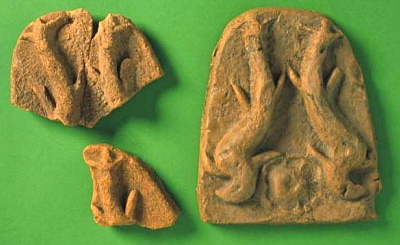
As well as Isca, Ptolemy assigns three other towns to the Dumnonii, none of which are identified. Generally speaking, though, the Dumnonii appear to have been little influenced by ‘Romanization’.
Unique to the Land’s End peninsula and Isles of Scilly are a class of compartmented dwellings called ‘courtyard houses’. These stone built houses, roughly circular in plan, consist of a number of rooms arranged around a central ‘courtyard’ – it is generally thought that the rooms had individual thatched or turf roofs, whilst the central space was an open courtyard.[*] The houses are found singly or in village groups – the best known villages being at Chysauster (about 4 miles north of Penzance) and Carn Euny (about 5 miles east of Penzance).[*] It seems that courtyard houses were built, flourished, and abandoned all within the period of Roman occupation.
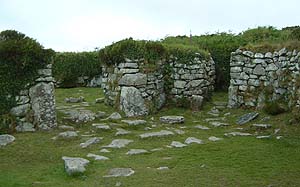
The archaeological evidence at Carn Euny shows that the courtyard houses were the final phase of development on the site. A component of previous – i.e. later Iron Age (c.400 BC–AD 43) – construction is a subterranean passage, known generically as a ‘souterrain’, but in Cornwall by the local term ‘fogou’. The purpose of fogous is the subject of debate – places for storage or for religious activities are favourite contenders. There is also a fogou at Chysauster (but in a poor state and blocked off), however, unlike at Carn Euny, no earlier dwellings have, as yet anyway, been found.
18:Iceni 19:Catuvellauni 20:Trinovantes 21:Cantiaci
The Trinovantes [20] lived in the south-east of England, north of the Thames – roughly, modern Essex. In The Gallic War, Julius Caesar wrote that, during his campaign of 54 BC, the British opposition was commanded by one Cassivellaunus.[*] However, Cassivellaunus had been extending his (unnamed, but north of the Thames) tribe’s territory, and had killed the king of the Trinovantes. The Trinovantes submitted to Caesar in exchange for his protection against Cassivellaunus. The Trinovantes – meaning ‘very vigorous’, ‘most lively’, or similar – were, says Caesar, “about the strongest tribe in that part of the country” (V, 20), and following their example, other tribes now submitted to Caesar: the Cenimagni, the Segontiaci, the Ancalites, the Bibroci and the Cassi. These five tribes are otherwise unknown, but they were evidently close neighbours of Cassivellaunus, since they were able to betray the location of his stronghold (oppidum) to Caesar. Though a site at Wheathampstead (where extant earthworks are known as the Devil’s Dyke and the Slad), to the north of St Albans, is often mentioned as possibly being Cassivellaunus’ stronghold, which Caesar proceeded to conquer, the location, in fact, remains unknown. Anyway, Cassivellaunus was obliged to surrender to Caesar, who returned to Gaul, taking hostages with him. No more is heard of Cassivellaunus. It seems fairly certain that his tribe was the Catuvellauni (having a meaning along the lines of ‘men good in battle’) – or what would become the Catuvellauni after, perhaps(?), annexing the five tribes (or four of them anyway) that disappear from history subsequent to Caesar’s expedition. The Catuvellauni [19] were the Trinovantes’ western neighbours – centred on Hertfordshire, with the Thames as their southern border.
It may be that Caesar’s Cenimagni were the Iceni [18].[*] The Iceni’s territory was centred on Norfolk – they were the Trinovantes’ northern neighbours. The richest Iron Age treasure discovered in Britain has been unearthed at Snettisham in Norfolk. A burial date round-about 80 BC is suggested by imported Gallo-Belgic coins included in the hoards. From about 50 BC the Iceni were striking their own coins, but it wasn’t until about AD 20 that inscriptions were introduced to the coinage.[*] It is not certain, however, quite what the inscriptions represent. For instance, CANI DVRO, which may, or may not, be an abbreviated ruler’s name and mint-mark; and ECEN has widely been taken to be a version of the tribe’s name, but, if so, this would be unique for British Iron Age coinage, and it must be just as likely that it represents a ruler’s name (or something else entirely).[*]
The first indigenous British coins (not struck, but cast in a tin-rich bronze, and known as ‘potins’) were probably produced in Cantium, i.e. Kent, around the end of the second century BC. Caesar claimed that “the inhabitants of Cantium” were:
By far the most civilized of all the natives [of Britain] … whose culture does not differ much from that of the Gauls.The Gallic War V, 14
And he mentions:
… Cingetorix, Carvilius, Taximagulus, and Segovax, the four kings who ruled over the country [i.e. Cantium] …The Gallic War V, 22
Presumably, each king ruled his own tribal sept, but Caesar doesn’t elucidate. In fact, he doesn’t give “the inhabitants of Cantium” a tribal name at all, but they would later become the civitas of the Cantiaci [21] (also known as the Cantii).
On his departure from Britain, Caesar had warned Cassivellaunus not to wage war on the Trinovantes, but, from the evidence of inscribed coins and a few scraps of classical text, a possible train of events can be constructed, in which the expansionist ambitions of the Catuvellauni precipitated the Claudian invasion of AD 43.[*]
At the time of the invasion, the Catuvellauni’s dominions apparently included the Trinovantes and the Cantiaci. Indeed, they had made the ‘territorial oppidum’ of Camulodunum (Colchester, Essex), in Trinovantian territory, ‘capital’ of the expanded realm. British opposition to the invading Roman army was led by Catuvellaunian rulers: the brothers Caratacus and Togodumnus. They were defeated. Togodumnus was killed, but Caratacus escaped – disappearing, but only temporarily, from history. Camulodunum was captured and a legionary fortress was built there.[*]
Late in 47, Publius Ostorius Scapula arrived in Britain to begin his term as governor. He received, says Tacitus:
… a troubled reception, as the enemy [evidently the unconquered tribes of, what is now, Wales] had poured into the territory of our allies with a violence all the greater from their belief that a new commander would not take the field with an untried army and with winter begun.Annals XII, 31
Having swiftly dealt with the immediate problem, Scapula:
… to obviate a second rally, to be followed by a sullen and disloyal peace which would allow no rest either to the general or his troops – prepared to disarm the suspect and to overawe the whole district on this side [i.e. the Roman side] of the Trent and Severn.Annals XII, 31
Until this time, the Iceni had not opposed the Romans:
… the Iceni, a powerful community not yet broken in battle, as they had voluntarily acceded to our alliance.Annals XII, 31
They were, nominally, independent under their own king. Now, however, presumably insulted at being “suspect” by the new governor, and having no intention of being disarmed, the Iceni instigated a rebellion. The rebels were, however, easily beaten.
By the Icenian defeat all who were wavering between war and peace were reduced to quietude …Annals XII, 32
Remarkably, the Iceni retained their status as a client-kingdom. It may be, though, that the Romans installed a more compliant member of the Icenian aristocracy, one Prasutagus, as king following the rebellion.
Scapula then set-out to subdue the Welsh tribes. The Silures [12] proved to be particularly troublesome. Probably in 49, to release troops for service against the Silures, but still keep his back protected, he replaced the legionary fortress at Camulodunum with a colonia (a town for legionary veterans). Leading the Silures’ forces was, erstwhile Catuvellaunian ruler, Caratacus. Eventually, in 51, he was captured and taken to Rome.[*]
Meanwhile, in the Catuvellaunian homeland, the native population had quickly settled down to life under Roman rule. The town of Verulamium (at modern St Albans, Hertfordshire) was being developed within the existing ‘territorial oppidum’ (which had evidently been the tribal ‘capital’ before being superceded by Camulodunum). During excavations at Folly Lane, St Albans, in 1991–2, the rich burial, dating from the early-50s, of a high-status native was discovered. The archaeological evidence doesn’t indicate there was a significant Roman military presence at Verulamium, and it has been conjectured that the wealthy individual from Folly Lane was an unrecorded client-king of the Catuvellauni.[*] Further, it has been suggested that this man might be Adminius (usually equated with Amminus, who issued coins in Kent[*]), a brother of Caratacus and Togodumnus, who was, according to Suetonius (Lives of the Twelve Caesars ‘Gaius Caligula’ 44), banished by their father, in about 40, and surrendered himself to the emperor Caligula – the surmise being that Adminius was expelled from Britain for his pro-Roman opinions, but returned in the wake of the Roman invasion and was made king of the Catuvellauni.[*] The Catuvellauni, therefore, possibly had a period as a client-kingdom prior to becoming a civitas.[*] Verulamium was plainly the civitas capital, though it is nowhere clearly attested.
Perhaps surprisingly, the Cantiaci, “by far the most civilized of all the natives”, seem to have been slower to adapt to the new order. Unlike Verulamium, Durovernum Cantiacorum (now Canterbury), the civitas capital – also sited within an existing ‘territorial oppidum’ – does not exhibit signs of early Romanization.[*]
Around 59–60 Prasutagus, client-king of the Iceni, died. He was, notes Tacitus (Annals XIV, 31), “celebrated for his long prosperity”. How long is “long”? Well, Prasutagus could already have been king in 43, at the time of the invasion, and, if so, he must have opposed the rebellion of c.48. It is, though, widely suggested he was planted on the throne by the Romans following the rebellion. At any rate, prior to his death Prasutagus had taken the expedient measure of making:
… the emperor his heir, together with his two daughters; an act of deference which he thought would place his kingdom and household beyond the risk of injury.Annals XIV, 31
He was sorely mistaken. His kingdom was pillaged. His wife, Boudica:
… was subjected to the lash and his daughters violated: all the chief men of the Iceni were stripped of their family estates, and the relatives of the king were treated as slaves.Annals XIV, 31
The result was Boudica’s Rebellion. Allies of the Iceni were:
… the Trinovantes and others, who, not yet broken by servitude, had entered into a secret and treasonable compact to resume their independence.Annals XIV, 31
The hated veterans at Camulodunum were the first target of the rebels. They then destroyed the towns of Londinium (London) and Verulamium:
… as the natives, with their delight in plunder and their distaste for exertion, left the forts and garrison-posts on one side, and made for the point which offered the richest material for the pillager and was unsafe for a defending force.Annals XIV, 33
In the decisive battle, at an unknown site, the Romans, although vastly outnumbered, were victorious over the undisciplined rebels. There would have followed a period of direct military rule for the Iceni, but at some stage they became a civitas, with its capital at Venta Icenorum (Caistor St Edmund, near Norwich).
Camulodunum, Verulamium and Londinium recovered from the devastation wreaked by Boudica. Camulodunum is the only town assigned to the Trinovantes by Ptolemy, so the tribe would appear to have been administered from the colonia. It is possible that a place on the route between Londinium and Camulodunum was given the rather grand name Caesaromagus (now Chelmsford) in anticipation of it becoming civitas capital of the Trinovantes. There is, though, neither written nor archaeological evidence to indicate that this ever occurred. Perhaps the plan was overtaken by the events just described, and never came to fruition.
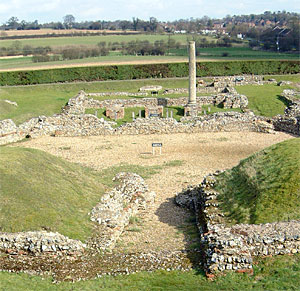
In his description of the Boudican revolt, Tacitus describes Verulamium as a municipium. Like a colonia, a municipium was self governing and had its own surrounding territory. However, whilst a colonia was a town created for retired legionaries (by definition, Roman citizens), the rank of municipium conferred some privileges of citizenship to an existing town (hence, a municipium was of lower status than a colonia). Verulamium is the only reported municipium in Britain, but if it really was a municipium – maybe Tacitus used the term as a literary device, to underline the magnitude of Boudica’s transgressions – it seems reasonable to suppose there were others. Then again, assuming Verulamium was a municipium, it may not have been such in 60 – Tacitus may have been applying the term retrospectively. Whatever its status, Verulamium became the third largest town in Roman Britain – Londinium being the first, and Corinium Dobunnorum (Cirencester), civitas capital of the Dobunni [15], the second.
Londinium developed, on a greenfield site, at the northern end of a Thames crossing place. (The town was on the northern bank of the river, but Ptolemy, presumably in error, assigns it to the Cantiaci.) It sprang up soon after the invasion – a timber drain has been dated, by dendrochronology, to AD 47 – and grew quickly:
Topsoil was removed from large areas, hillsides flattened and valleys infilled. Road front properties were snapped up, and by the end of the 50s the whole place was built over. This density of development has prompted us to revise our estimates of London's early population size. We now think that it may have been as great as 10,000 by AD 60 – roughly double what was thought before the Poultry excavation, and half the estimated maximum population of 20,000 when it peaked in the early 2nd century.Peter Rowsome, in British Archaeology Issue 54 (August 2000).
Tacitus says that, at the time of the Boudican revolt, Londinium:
… though not distinguished by the title of colonia, was none the less a busy centre, chiefly through its crowd of merchants and stores.Annals XIV, 33
Excavated artefacts indicate the population of pre-Boudican Londinium was predominantly male. It probably had much the same sort of character as a town from the Wild West; with a cosmopolitan population of officials, merchants, tradesmen, chancers and snakeoil salesmen. Londinium rose from the ashes of Boudica’s destruction on a grander scale. It seems quite possible that the headquarters of the procurator, the official in charge of the finances of the whole province, were already at Londinium pre-Boudica – they evidently were immediately afterwards.
tri07
It may be assumed that he died at latest c.65, for a term of more than four years would be unlikely.Pieces of Classicianus’ tombstone were found, in London, in 1852, 1885 and 1935. They had been incorporated into the Roman city’s wall during the 4th century. The reconstructed memorial (below) is in the British Museum.The Roman Government of Britain (2005) p.303
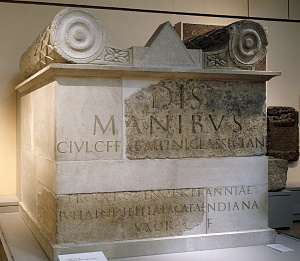 The inscription (RIB 12) translates as:
The inscription (RIB 12) translates as:
To the spirits of the departed (and) of Gaius Julius Alpinus Classicianus, son of Gaius, of the Fabian voting-tribe … [2 missing lines] … procurator of the province of Britain; Julia Pacata I[ndiana?], daughter of Indus, his wife, had this built.
22:Atrebates 23:Belgae 24:Regni
Julius Caesar begins The Gallic War with the comment:
Gaul, taken as a whole, is divided into three parts, one of which is inhabited by the Belgae, another by the Aquitani, and a third by a people who call themselves Celts and whom we call Gauls. These peoples differ from one another in language, institutions, and laws.
Later, Caesar – he campaigned in the south-east of, what is now, England in 55 BC and 54 BC – mentions that:
The interior of Britain is inhabited by a people who, according to oral tradition – so the Britons themselves say – are aboriginal; the maritime districts by immigrants who crossed over from Belgium to plunder, and attack the aborigines, almost all of them being called after the tribes from whom the first comers were an offshoot.The Gallic War V, 12
One of the Belgic tribes of Gaul was the Atrebates. It seems that, in about 50 BC, Commius, erstwhile king of the Atrebates, migrated to Britain.[*] It is thought that Commius equates to COMMIOS, a name which features on the earliest inscribed British coins. Caesar makes no mention of a British Atrebates tribe in the mid-1st century BC, but they are recorded by Ptolemy in the mid-2nd century AD. It is possible then, that they began as a federation of various immigrant and indigenous groups, living between the middle Thames and the south coast (roughly: modern Berkshire, Surrey, Hampshire, West Sussex), founded by Commius himself. (In fact, of all the Belgic tribes named by Caesar, only the Atrebates has a known British counterpart.) From the evidence provided by inscribed coins, and a few mentions in classical texts, a possible chain of events can be constructed, culminating in the appeal for Roman intervention by Verica, deposed king of the British Atrebates (by then, reduced to just the southern part of their former territory), which led to the Claudian invasion of Britain in AD 43.[*]
It isn’t known where the invasion fleet landed – indeed, whether the whole fleet landed at the same place – but modern scholarly opinion tends to be divided between those preferring Richborough, on the east coast of Kent (the traditional favourite), and those advocating the Chichester area of West Sussex. Both these places have provided archaeological evidence of early Roman activity, but no conclusive evidence that they were the actual landing-site.
Excavations at Fishbourne, close by Chichester, in the 1960s, uncovered the traces of what was identified as an invasion-period Roman military supply depot.[*] This military phase was evidently short lived, however, being quickly followed by further, civilian, developments, until, in about 75, work began on the construction of a large and imposing residence – a veritable palace. The layout consisted of four wings arranged around a rectangular formal garden. The vast entrance hall was in the centre of the east wing. Opposite, in the centre of the west wing, reached by a hedge lined avenue through the central garden, was the, so-called, ‘audience chamber’. The big question is: who was this palace built for? Well, conjecture centres on one Togidubnus (also known as Cogidubnus).
Tacitus writes:
The first of the consular governors [of Britain] was Aulus Plautius [43–47], who was succeeded by Ostorius Scapula [47–52]: both were distinguished soldiers. By degrees the nearest part of Britain [to Rome, i.e. the south-east] was reduced into the form of a province, and a colonia of veterans was founded. Certain civitates were bestowed as a gift on the king, Cogidumnus, whose allegiance lasted up to our own time. It is indeed an old-established principle of Roman government to employ the kings themselves as instruments of slavery.Agricola 14
In the above brief passage, Tacitus sums up nine years of British history. His phraseology has been taken to imply that Cogidumnus was already ruling a kingdom prior to the establishment of the colonia (a town for legionary veterans) at Camulodunum (Colchester, Essex), which was probably in 49, and at that time, or soon after, his realm was augmented by the addition of “certain civitates”, i.e. other tribal territories.[*] On the other hand, a simpler interpretation would be that, at some time between 43 and 52, Cogidumnus was granted an extensive kingdom comprising a number of civitates.[*] What Tacitus certainly doesn’t indicate is where that kingdom was.
In 1723, a slab of Purbeck marble with an undated Latin inscription (RIB 91) was found in Chichester (called Noviomagus in Roman times). The left hand side of the slab was missing, and the rest broke into four pieces during its retrieval. The reconstructed inscription refers to: “Tiberius Claudius Togidubnus, great king in Britain”. In fact, the first two letters of the name Togidubnus are missing from the inscription, but it is now thought that, on linguistic grounds, TO, rather than CO, is likely to be correct. Either way, there is no doubt that this man is Tacitus’ King Cogidumnus.[*] Because of the inscription’s imperfect condition, the reading “great king” is not 100% guaranteed. It is, however, both possible and plausible – it certainly fits neatly with Tacitus’ remark.[*]
Togidubnus, then, was a favoured client-king. His full, three-part, name indicates that he had received Roman citizenship – probably from Emperor Claudius (41–54). He was probably an Atrebatic aristocrat – in all likelihood a relative of Verica (whose fate is unknown).[*] If Noviomagus was Togidubnus’ capital, which seems a reasonable supposition, then it also seems reasonable that he had an estate just a couple of miles to the west, at Fishbourne.
It could be more than coincidence that the palace was built during the reign of Vespasian (69–79). Vespasian had participated in the Claudian invasion of Britain – commanding the Second Legion (II Augusta[*]), with which he proceeded to subdue the Isle of Wight and the south-west of England.[*] (It has, reasonably, been suggested that the first phase of building on the Fishbourne site acted as a supply depot during Vespasian’s campaign.[*]) Togidubnus may have got to know Vespasian at that time. It is even possible that an exiled Togidubnus returned to Britain in Vespasian’s company. In short, the two men might have become friends. In which case, Togidubnus could have supported Vespasian’s cause during, and in the aftermath of, the tumultuous year of 69, the Year of the Four Emperors, from which Vespasian emerged triumphant. Maybe Vespasian was so grateful, for his old friend’s backing, that he funded the building of the palace at Fishbourne. On the other hand, it is quite possible that Togidubnus was already dead, and his kingdom split up, by the time the palace was begun (c.75).[*] In truth, the link between King Togidubnus and Fishbourne Palace is neat, but completely unsubstantiated.
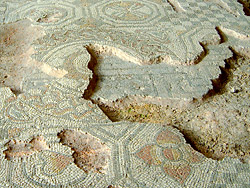
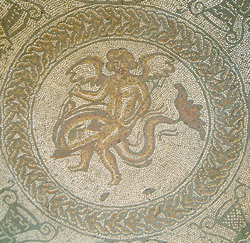
The palace remained in use for some two centuries. It underwent considerable alteration until the 280s, when, with building work still underway, it was devastated by fire. It was abandoned and used as a source of building materials.


Togidubnus does not appear to have issued any coins. If he had, their distribution would have given an indication of the extent of his domain. However, it seems reasonable to suppose that it comprised the cluster of three civitates based between the middle Thames and the south coast (the territory associated with Commius), which, following Togidubnus’ death, functioned independently of each other:
| i. | To the north, were the Atrebates [22]. Their capital, Calleva Atrebatum, is now Silchester, Hampshire. |
| ii. | In the west, were the Belgae [23]. Their capital, Venta Belgarum, is now Winchester, Hampshire. The Belgae were one of the three population-groups of Gaul named by Julius Caesar, not an individual tribe, so the civitas seems to be an artificial division imposed by the Romans. Ptolemy assigns the town of Aquae Calidae (‘hot springs’) to the Belgae. This can only be modern Bath, in Somerset, and presumably is what the place was called before it acquired the more familiar Roman name of Aquae Sulis.[*] If Ptolemy is not mistaken, it would seem that the southernmost territory of the Dobunni [15] had been split off and incorporated into the Belgae. |
| iii. | In the east, based on Togidubnus’ presumed capital, Noviomagus (Chichester, West Sussex), were the Regni [24]. The name Regni comes from Ptolemy, and, if correct, their civitas capital would be titled Noviomagus Regnorum. In the Ravenna Cosmography, though, their civitas capital is rendered Navimago Regentium. There is a long-standing theory that Regentium should be emended to Regnensium – hence the people should be called the Regnenses, which conveniently allows a link to be made with Togidubnus, since the name can be translated as ‘the people of the kingdom’ (Latin regnum = kingdom). This wordplay may, however, be nothing more than wishful thinking – “more than rash”, according to linguist Kenneth Jackson.[*] Professor Jackson, a Celtic language specialist, proposed that they should actually be the Regini, a British name translating along the lines of ‘the proud ones’ (indicating that they were a pre-existing tribal grouping, not a Roman creation), and that the first ‘i’ has been dropped as the word has been assimilated into Latin.[*] Further, in the British section of the Antonine Itinerary, Iter VII is a route from a place called Regno, travelling, via Venta Belgarum and Calleva Atrebatum, to Londinium. Regno is apparently Noviomagus. Another long-standing notion has it that Regno should be interpreted as ‘the kingdom’ (regno is the ablative of regnum), but, in all probability, it is a contraction of the tribal epithet, Reg(i)norum – just as, in Iter V, Venta Icenorum, civitas capital of the Iceni [18], is called Icinos.[*] Nevertheless, there is seemingly a scholarly reluctance to abandon the neatness of linking the later civitas name with King Togidubnus.[*] |

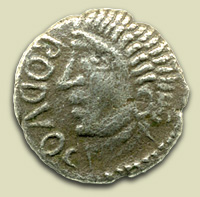
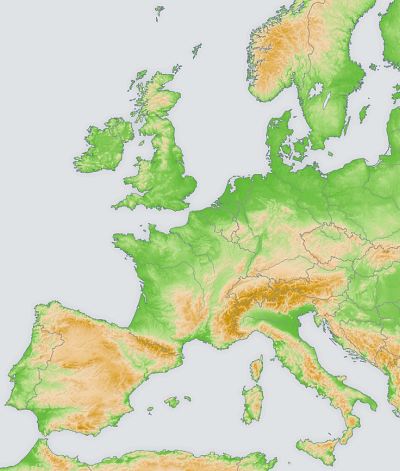
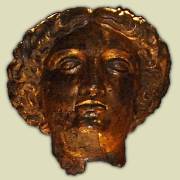 Sulis was the native goddess of the springs at Bath. The Romans equated her with their own goddess Minerva, and her name appears in coupled form, ‘Sulis Minerva’, on inscriptions from Bath.
This gilded bronze head of Sulis Minerva, discovered in 1727, would have been part of a, slightly bigger than life-size, statue. It can be seen at
Sulis was the native goddess of the springs at Bath. The Romans equated her with their own goddess Minerva, and her name appears in coupled form, ‘Sulis Minerva’, on inscriptions from Bath.
This gilded bronze head of Sulis Minerva, discovered in 1727, would have been part of a, slightly bigger than life-size, statue. It can be seen at 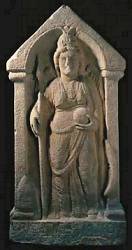 The sculpture pictured (93cm high) was found at Birrens (Dumfries and Galloway, Scotland), a Roman outpost beyond Hadrian’s Wall, in 1731. The inscription reads: “Sacred to Brigantia: Amandus, the engineer, by command fulfilled the order.” The figure is in the guise of Minerva, Roman goddess of wisdom, war and crafts, with the wings of Victoria. The sculpture is now in the
The sculpture pictured (93cm high) was found at Birrens (Dumfries and Galloway, Scotland), a Roman outpost beyond Hadrian’s Wall, in 1731. The inscription reads: “Sacred to Brigantia: Amandus, the engineer, by command fulfilled the order.” The figure is in the guise of Minerva, Roman goddess of wisdom, war and crafts, with the wings of Victoria. The sculpture is now in the 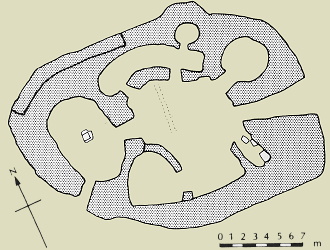 Plan of House 6 at Chysauster. Long Room at top, Round Room at left.
Plan of House 6 at Chysauster. Long Room at top, Round Room at left.
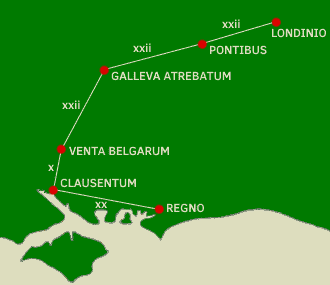 If the identification of Clausentum is correct, the simplest explanation is that an x has been lost during the text’s transmission (i.e. xx should read xxx). A.L.F. Rivet writes:
If the identification of Clausentum is correct, the simplest explanation is that an x has been lost during the text’s transmission (i.e. xx should read xxx). A.L.F. Rivet writes:
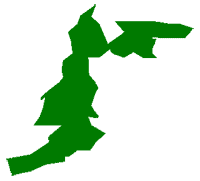 In his Geography, of c.AD 150, Greco-Egyptian mathematician, astronomer and geographer, Claudius Ptolemaeus, known as Ptolemy, produced a set of coordinates which allow a rudimentary map of the world as he knew it to be drawn. Britain’s shape (seen on the right) is actually very distorted on this map – the North skewing wildly eastwards. Ptolemy gives a description of the layout of tribal territories within Britain, and names and coordinates for a number of ‘towns’ – poleis (singular: polis) is the term he uses for all the named places, regardless of size or sophistication – which he allocates to the appropriate tribe. Though Ptolemy was writing in the mid-2nd century, the bulk of his data was considerably older. He drew extensively on the work of one Marinus of Tyre, who was probably working in the years about AD 100, though, in the case of Britain, the original source of the material can only have been the Roman military.
In his Geography, of c.AD 150, Greco-Egyptian mathematician, astronomer and geographer, Claudius Ptolemaeus, known as Ptolemy, produced a set of coordinates which allow a rudimentary map of the world as he knew it to be drawn. Britain’s shape (seen on the right) is actually very distorted on this map – the North skewing wildly eastwards. Ptolemy gives a description of the layout of tribal territories within Britain, and names and coordinates for a number of ‘towns’ – poleis (singular: polis) is the term he uses for all the named places, regardless of size or sophistication – which he allocates to the appropriate tribe. Though Ptolemy was writing in the mid-2nd century, the bulk of his data was considerably older. He drew extensively on the work of one Marinus of Tyre, who was probably working in the years about AD 100, though, in the case of Britain, the original source of the material can only have been the Roman military.